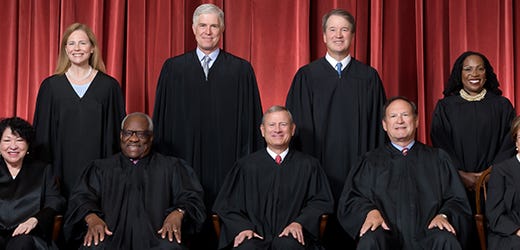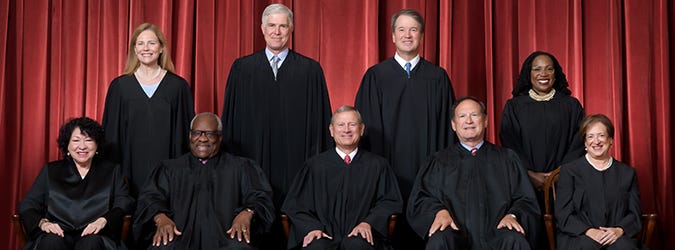In 1981, the Environmental Protection Agency (EPA), under Administrator Anne Gorsuch (the mother of Supreme Court Justice Neil Gorsuch), decide to change how it defined a “source” of pollution under the Clean Air Act Amendments of 1977. An environmental group, the National Resources Defense Council (NRDC) petitioned the EPA in federal court arguing that there was a right way to define “source” and EPA’s new definition was incorrect.
In a decision written by Justice Ruth Bader Ginsberg (the future Supreme Court justice), the federal appeals court sided with NRDC and against President Reagan’s EPA. Chevron, the oil company, was affected by the regulations, giving the company standing to sue, and appealed the decision to the U.S. Supreme Court.
The resulting Supreme Court judgment — Chevron U.S.A. Inc. vs Natural Resources Defense Council — overturned the earlier NRDC victory. The Supreme Court judgement established what came to be known as Chevron Deference — the principle that when Congressional legislation is ambiguous or silent on how to interpret a statue, the courts should defer to agency interpretations of those statutes. For instance, EPA’s definition of a “source” of pollution.
Yesterday, in a 6-3 ruling along ideological lines the U.S. Supreme Court overturned Chevron. I would have joined the dissent (Justice Kagan’s dissent is outstanding) but at the same time, I would argue that the Chevron doctrine was problematic to the extent that it created opportunities for the executive branch to take action not enacted by Congress via statutory deference.
My views are influenced by the excellent analysis of legal scholar Cass Sunstein, who observes that Chevron was once favored by the right and opposed by the left, and those positions have now switched:
Once celebrated by the right and sharply criticized by the left, Chevron is now under assault from the right and (for the most part) accepted on the left. More particularly: The decision was originally embraced by the right as an effort to cabin the illegitimate exercise of policymaking authority of unelected judges, who were often requiring greater regulatory activity, and to insist instead on the primacy of officials within the Executive Branch, who have the advantage of democratic accountability. On this view, Chevron shifted authority from unaccountable judges, who had policy goals of their own, to policymaking officials.
The principal objections came from the left, which saw Chevron as an effort to weaken judicial review and as a capitulation to the (insufficiently zealous) administrative state, which was often captured by powerful private interests, and which often failed to regulate as Congress directed. Relatively aggressive judicial review, certainly on questions of law, was necessary to counteract the risk of “capture” and violations of congressional directions.
Ambiguities in legislation are unavoidable for practical reasons and often even necessary to create space for political compromise. For instance, in my PhD dissertation of 30 years ago I evaluated the law which established the U.S. Global Change Research Program. I argued that the program was headed towards failure because Congress directed it to provide “usable information for policymakers” related to climate change, but the federal science agencies interpreted that phrase to mean the development of predictive climate models — and not information more directly related to mitigation and adaptation policies.
I quoted James Madison from Federalist 37 on this point:
All new laws, though penned with the greatest technical skill and passed on the fullest and most mature deliberation, are considered more or less obscure and equivocal, until their meaning be liquidated and ascertained by a series of particular discussions and adjudications.
In practice, in regulatory policy making, even with Chevron overturned, agencies will continue to have discretion in how to interpret ambiguity in statutes. Chevron applied to situations where agency regulation were challenged.
Justice Kagan, in her dissent, provides an example of such ambiguity:
Under the Endangered Species Act, the Fish and Wildlife Service must designate endangered “vertebrate fish or wildlife” species, including “distinct population segment[s]” of those species. 16 U. S. C. §1532(16); see §1533. What makes one population segment “distinct” from another? Must the Service treat the Washington State population of western gray squirrels as “distinct” because it is geographically separated from other western gray squirrels? Or can the Service take into account that the genetic makeup of the Washington population does not differ markedly from the rest?
Noting that there are multiple different ways to define concepts such as “distinct population segments,” she asks:
A question thus arises: Who decides which of the possible readings should govern?
In 2024 in the United States, one answer to this question among conservatives might be “conservatives” and “liberals” among liberals.
That’s no way to interpret law or to implement policy.
As a practical matter, evidence suggests that Chevron actually reduced partisanship in judicial rulings. A study cited by Sunstein (Barnett et al. 2018) found that under Chevron:
The most recent data suggest that Chevron is indeed reducing the effects of judicial policy preferences. In a comprehensive study, Kent Barnett, Christina L. Boyd, and Christopher J. Walker found that Chevron “significantly curbs” demonstrably partisan rulings. When the most liberal judicial panels review conservative agency interpretations, they strike them down eighty-two percent of the time when they do not use Chevron, but just forty-nine percent of the time when they do. When the most conservative judges review liberal agency interpretations, they strike them down eighty-two percent of the time when they do not use Chevron, but just thirty-four percent of the time when they do.
Unsurprisingly, liberal panels are more likely than conservative panels to agree with liberal agency interpretations, and conservative panels are more likely than liberal panels to agree with conservative agency interpretations. But in Chevron cases, the difference between the two is greatly compressed.
Of course, for some partisans, judicial policy making from the bench is a feature, not a flaw — if their folks have a majority on the bench. Similarly, if the choice is between a perceived politicized executive branch and a politicized judiciary, many will go with their team over what might make sense legally or for effective policy making.
Returning to Justice Kagan’s squirrels, the answer to her well-posed question is that subject matter experts in the Fish and Wildlife Service will continue to make an initial decision about what constitutes a “distinct population segment” of squirrels and use that definition to promulgate regulatory actions. Such actions, as they always have been, would be subject to review and challenge by the courts. Agency decision making will no longer be granted Chevron deference, but it will be “entitled to respect” — what is called Skidmore deference, to cite another legal precedent which was cited yesterday by both the majority decision and the dissent.
There will be a period of uncertainty as the courts figure out post-Chevron, but something akin to Chevron will necessarily have to take its place.
From this standpoint, I have fewer concerns than many that the impact of yesterday’s decision will limit or even exclude experts from resolving challenges to regulatory decision making. A court is not going to decide that a lion is a squirrel. But it very well may define a “distinct population segment” or a “source” of pollution in ways that favor certain economic or political interests over others. Agencies too. That is science-in-politics as usual.
Individuals in the federal agencies and in the courts will continue to use their positions to try to influence policy in their preferred directions. The game hasn’t changed, but there are some new rules.
The overturning of Chevron should get the attention of Congress. If, as Justice Kagan suggests, Congress has been generally happy with Chevron in the 40 years that it has been in place (as shown by not acting to overturn it, she argues), then Congress could act in ways to clarify agency deference overall or specifically in the context of particular legislation. This Congress won’t but a future Congress might.
I would not have overturned Chevron. At the same time, now that it has been overturned we should take the opportunity it provides to open up discussion and debate on the roles of agency experts in policy making and how to make best use of science and evidence in contested political settings. Chevron or not, that challenge endures.
Recommended reading:
Sunstein, C. R. (2018). Chevron as law. Geo. lJ, 107, 1613.
❤️Please click the heart to help this post reach more readers!
THB exists because of your support. Please subscribe and share. Comments welcomed!






Understand your point of views, but I think Chevron decision decades ago is tied, disparately, to when Congress dropped most of the body’s work - writing laws and knowing what it says, passing budgets on time instead of simply relying on contingency and continuing budgets, earmarks (that left and now are back) and never-ending electioneering. Forcing Congress back to work after 40 years of lazy inaction is ok with this citizen.
Roger, correct me if I am wrong, but I understood that the original justification for Chevron deference was the assumption that subject matter experts in federal agencies would be detached unbiased sources of scientific data and logic on questions for which courts would not necessarily be well equipped to understand. Unhappiness with Chevron deference began to build when executive agencies began to manufacture "ambiguities" which allowed those agencies to expand their powers in ways well beyond the original intent of the statute. The injustices arising from the controversy on how to define the "Waters of the United States" is a prime example. When a "significant nexus" with "navigable waters" was expanded by federal agency fiat to include a house lot in a subdivision and drainage ditches 60 miles from the nearest river, it appeared to many of us that Chevron deference was out of control and over-ripe for reform.